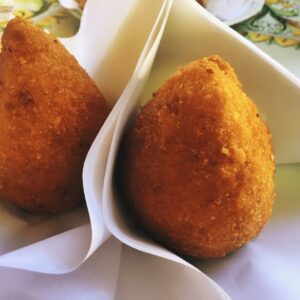Arancino (arancina) is perhaps one of the most famous Sicilian specialties in the world, perhaps the street food par excellence on the island.
It is a stuffed cone (or sphere)made of rice, breaded and fried. Very similar to a rice timbale.
If we talk about shape and size we can say that these rice balls have sometimes pyramidal shape and sometimes round shape.
Its filling varies according to the area of Sicily in which it is prepared.
Is it called arancino or arancina?
There is a dispute on the island, mainly between Catania and Palermo, about the name: Is it called arancino or arancina?
In the area of Palermo the name used is “arancina” in the eastern part of the island the name is “arancino”.

Obviously the Crusca Academy expressed itself (after the various requests) on this epic clash between western and eastern Sicily, which in any case they did not want to unbalance. They simply listed reliable sources for both ways of calling this emblem of Sicily.
I will prefer (only out of habit) to call it arancino (I’m from Catania) and I hope the Palermitans don’t get upset about it.
History of the arancino (arancina)
The traditional recipe is that of arancino filled with ragù (meat and tomato sauce). The most popular kind of arancini after the Ragù arancino are those filled with butter and cooked ham, spinach, aubergines and those with pistachio from Bronte.
Its name comes from oranges, as it recalls them by color and shape. This typical Sicilian recipe seems to be the result of different cultures that have been present on the island.
It may originally be linked to Arab culture which often used saffron-flavored rice dishes topped with vegetables or lamb. Then, during the reign of Frederick II of Swabia, the breading and frying arrived, to make the mixture more compact (and certainly tastier).
In reality we cannot find documents that speak of this typical dish before the mid-nineteenth century when in the Sicilian-Italian dictionary of Giuseppe Biundi (1857), the arancinu is mentioned for the first time, as: “a sweet rice dish made in the shape of an orange “.
This might suggest that originally the recipe was that of a dessert, which perhaps over time reinterpreted towards the salty.
Another factor that pushes towards the fact that the arancino (a), as it is cooked today, is a more “modern” recipe is given by the undeniable question that the tomato arrived on the island only in the early nineteenth century.
Even if the true origins are difficult to confirm, it is certain that today this dish represents Sicilian street food in all parts of the island.
Santa Lucia in Palermo

A very important day in the Sicilian tradition is December 13, the day of Saint Lucia, when arancine and cuccia (another typical dish of the island’s tradition) are traditionally consumed.
On this day in the city of Palermo, thousands of arancine with infinite preparations and recipes are prepared, consequently eaten (in this case I use the feminine to respect the Palermitan tradition 100% … People from Catania don’t get upset :)).
So if you are looking for a good time to visit Palermo, choosing this date could be the one that will make you gain more weight and your stomach will surely thank you !!
<br>
Arancino recipe

The preparation of Sicilian arancini varies a lot throughout Sicilian cuisine which, thanks to its rich culinary tradition, has interpreted this recipe in many ways. If we travel around Sicily we will find arancini: with salmon, chicken, swordfish, cuttlefish ink, seafood, sausage, mushrooms etc …
How are Sicilian arancini made?
The recipe that we share will be that of traditional Ragù arancini, filled with is with meat and tomato sauce.
Obviously, the recipe is one of the infinite interpretations of what is a popular dish. Every Sicilian grandmother or mother will surely have her secret recipe.
Ingredients for 10 arancini
1 onion
1 kg of rice
50 gr of butter
1 teaspoon of saffron
1 vegetable cube
olive oil, salt, pepper
Ragù Stuffed
1 kg of minced beef (or if you prefer 500 gr of minced meat and 500 gr of gutted sausage)
300 gr of tomato sauce
300 gr of mozzarella
2 carrot
2 onion
1 tablespoon of sugar
olive oil, salt, pepper
Bread cover
1 egg
Flour
salt water
bread crumbs
oil (for frying)
Rice preparation
Fry the finely chopped onion in hot oil, add the rice until roasted, at which point add the vegetable cube, 2 liters of water, the saffron and a little pepper. Look at the cooking time of the rice and turn off the heat one minute before it finishes cooking. Add the butter and arrange it all in a bowl or on a tray to cool for 10 hours. Try to keep the rice moist (not wet), if it dries too much you can moisten it with oil.
Preparation of the filling
Fry the onion (yes in Sicily it is the basis of the kitchen ????) add the carrots and cook for 2 minutes, add the chopped meat (and possibly the sausage in little pieces), wait 3 minutes and add the peas, the tomato sauce, salt, peppe ans sugar. Cook everything for about half an hour over low heat, stirring often. After cooking, let the sauce cool.
Bred cover: mix the egg with the flour and a little salted water (less than a glass) until a creamy consistency is obtained
Here comes the best
We put everything we need in front of us: saffron rice, stuffing, batter and breadcrumbs.
Moisten your hands with oil, put a little rice on a palm trying to give it a concave shape, put the filling on the rice and a slice of mozzarella inside and close with more rice.
Try not to leave any air inside and pass the ball it in the batter and then in the breadcrumbs.
Now fry until golden brown and… you just have to taste the arancini, a piece of Sicily.
I hope that the recipe that I have proposed has been to your liking and I hope that the Sicilian grandmothers and mothers leave in the comments their advice for improving the recipe.
Greetings from the Sicilian Magpie.




